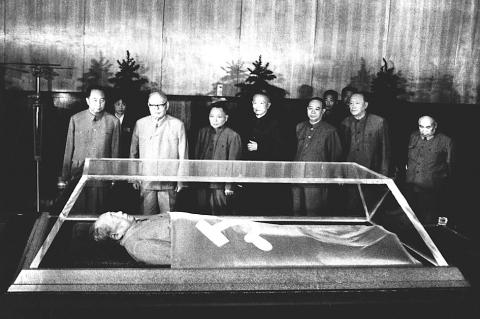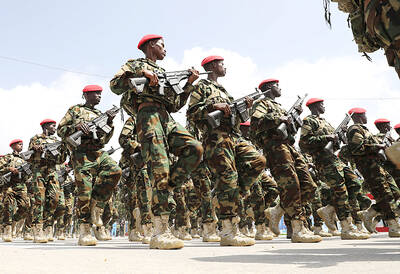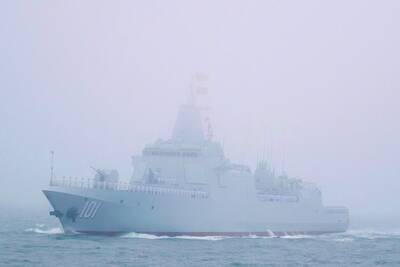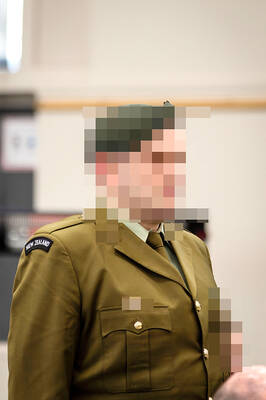Days after the People’s Republic of China’s (PRC) founding father Mao Zedong (毛澤東) died 40 years ago, the problem of what to do with his corpse was becoming increasingly heated — literally.
Mao himself had requested cremation, but powerful officials including his mercurial widow Jiang Qing (江青) decided he would join the likes of Vladimir Lenin and Ho Chi Minh in being embalmed and put on display.
Before the natural processes of decay could take hold, Xie Piao, an official overseeing an experimental thermoelectric cooling project, was summoned in the middle of the night and tasked with cooling the corpse.

Photo: AP
“No one expected that Chairman Mao would die, so there were no preparations at all,” said Xie, now 75, who said he then felt “quite proud” to be involved in preserving the Great Helmsman’s body.
He arrived at the cavernous Great Hall of the People four decades ago yesterday to find the prostrate body of the man who led the Chinese Communist Party (CCP) to victory, founding the PRC before plunging it into chaos, in a hastily constructed glass and wood coffin, at room temperature beneath hot electric lights.
“Our aim was to get the temperature down to 4 or 5oC,” he said, adding that about 400 people were involved in the entire project.
“We could not freeze him — that was his doctors’ order,” Xie said.
At the time, Chinese refrigeration systems were basic. With Soviet relations still on a war footing, asking Moscow for help was unthinkable and its ally Hanoi rebuffed calls for assistance, Xie said.
“I thought the technology was very reliable, it was very simple,” he said in what is believed to be his first interview with foreign media.
“The fear came later,” he said.
NEW METHOD
Within hours nitrogen gas surrounding the corpse had been bought down to a cool 8oC. However, that did not prevent Mao’s anointed successor, Hua Guofeng (華國鋒), berating Xie for using “experimental” techniques.
Senior leaders arrived day and night to bow before the body, adding to the seven-strong refrigeration team’s tensions.
“Once I was so tired I fell asleep in the middle of work. We had no time to sleep for five, seven days,” Xie said.
Mao’s death on Sept. 9, 1976, is seen as bringing to an end the destructive decade of Cultural Revolution he unleashed on his nation.
However, the period’s intense political atmosphere still permeated the corridors of the Great Hall.
“It was very serious, no one chatted,” Xie said.
When Jiang arrived to pay respects to her husband, Xie hid among the floral tributes for fear of becoming a focus for her notorious temper, according to an account he published for the first time this year.
Eight days after arriving at the Great Hall of the People, Xie’s work was declared complete.
He knows little of the embalming, said to have involved draining the corpse of fluids and injecting it with the chemical preservative formaldehyde.
Mao’s former doctor Li Zhisui (李志綏) published a ghoulish account of the process, describing the former ruler’s head swelling up “like a football.”
Xie dismisses it as “unreliable,” but whatever the details, Mao was put on permanent display in 1977 in a monumental pillared memorial hall in Beijing’s Tiananmen Square.
WAXY FACE
Mao lies in a dim chamber, garbed in a gray suit, his sallow waxy face framed by thick black hair bathed in a patch of orange light.
With debate about his legacy stifled by CCP authorities, he still retains a powerful hold over some sections of Chinese society and receives hundreds, sometimes thousands of visitors a day.
No detailed official account of the preservation efforts has been published.
The editorial staff of liberal intellectual magazine Yanhuang Chunqiu, or Annals of The Yellow Emperor, was purged in August, shortly after it published Xie’s account, in a sign of further tightening under current Chinese President Xi Jinping (習近平).
Xie, the son of a first-generation Communist who himself suffered in the Cultural Revolution, only visited the corpse once again — in the 1980s — and said he was “too busy” to pay any respects last week.
Top leaders also stayed away.
While still celebrating its former leader, the ruling party has acknowledged the “gross mistakes” of a man whose Great Leap Forward resulted in a famine that killed tens of millions of people in the early 1960s.
Intellectuals have periodically called for his body’s removal from the square.
However, Xie said: “Although there is controversy, I think that Mao’s corpse has been somewhat useful to China over the decades. The spirit of the Chinese people finds a focus on Chairman Mao’s body.”

ELECTION DISTRACTION? When attention shifted away from the fight against the militants to politics, losses and setbacks in the battlefield increased, an analyst said Recent clashes in Somalia’s semi-autonomous Jubaland region are alarming experts, exposing cracks in the country’s federal system and creating an opening for militant group al-Shabaab to gain ground. Following years of conflict, Somalia is a loose federation of five semi-autonomous member states — Puntland, Jubaland, Galmudug, Hirshabelle and South West — that maintain often fractious relations with the central government in the capital, Mogadishu. However, ahead of elections next year, Somalia has sought to assert control over its member states, which security analysts said has created gaps for al-Shabaab infiltration. Last week, two Somalian soldiers were killed in clashes between pro-government forces and

Ten cheetah cubs held in captivity since birth and destined for international wildlife trade markets have been rescued in Somaliland, a breakaway region of Somalia. They were all in stable condition despite all of them having been undernourished and limping due to being tied in captivity for months, said Laurie Marker, founder of the Cheetah Conservation Fund, which is caring for the cubs. One eight-month-old cub was unable to walk after been tied up for six months, while a five-month-old was “very malnourished [a bag of bones], with sores all over her body and full of botfly maggots which are under the

BRUSHED OFF: An ambassador to Australia previously said that Beijing does not see a reason to apologize for its naval exercises and military maneuvers in international areas China set off alarm bells in New Zealand when it dispatched powerful warships on unprecedented missions in the South Pacific without explanation, military documents showed. Beijing has spent years expanding its reach in the southern Pacific Ocean, courting island nations with new hospitals, freshly paved roads and generous offers of climate aid. However, these diplomatic efforts have increasingly been accompanied by more overt displays of military power. Three Chinese warships sailed the Tasman Sea between Australia and New Zealand in February, the first time such a task group had been sighted in those waters. “We have never seen vessels with this capability

‘NO INTEGRITY’: The chief judge expressed concern over how the sentence would be perceived given that military detention is believed to be easier than civilian prison A military court yesterday sentenced a New Zealand soldier to two years’ detention for attempting to spy for a foreign power. The soldier, whose name has been suppressed, admitted to attempted espionage, accessing a computer system for a dishonest purpose and knowingly possessing an objectionable publication. He was ordered into military detention at Burnham Military Camp near Christchurch and would be dismissed from the New Zealand Defence Force at the end of his sentence. His admission and its acceptance by the court marked the first spying conviction in New Zealand’s history. The soldier would be paid at half his previous rate until his dismissal